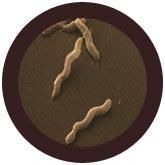Diarrhea (Campylobacter jejuni)

Your purchase supports the UN Foundation’s Shot@Life campaign which educates and empowers individuals to champion global vaccines to save the lives of children in developing countries. It has delivered millions of vaccines around the world. 10% of your purchase will be donated to Shot@Life.
Product Details
Additional Information
| Sizes | Giantmicrobes are based on actual microbes, cells, organisms and other critters, only 1,000,000 times actual size! Gigantic (GG) 16-24" XL (XL) 10-15" Original (PD) 5-8" Keychain (KC) 2-4" with clip |
|---|---|
| Materials | Plush from all new materials. Stuffed with polyester fiber fill. Surface washable: sponge with water & soap, air dry. |
| Packaging | Each plush microbe includes a printed card with fun, educational and fascinating facts about the actual microbe or cell. |
| Safety | Every product meets or exceeds U.S. and European standards for safety. For ages 3 and up. |
All about Diarrhea (Campylobacter jejuni)
FACTS: There are many causes of diarrhea, from medications, to artificial sweeteners, to lactose intolerances, to chronic diseases, to parasites and viruses. But bacterial infections are one of the more common causes, and Campylobacter is one of the most common culprits.
When physicians classify diarrhea, they wax expository with words like osmotic, secretory, or exudative – depending on how, whether, and which bodily fluids end up in the bowels. (The young, of course, enjoy their own unimitable vocabulary.)
But the primary medical difficulty with diarrhea – discomfort aside – is the substantial loss of fluids victims suffer, not to mention the loss of salts and minerals that are necessary to maintain normal bodily health.
The young and old are particularly vulnerable to dehydration and care should be taken to monitor for warning signs such as thirst (obviously), dry skin, light-headedness, crying without tears, dry diapers for unusually long periods, and reduced activity levels.
And as always, prevention is the best medicine. The corkscrew-shaped campylobacter bacterium, like so many others, is commonly contracted from undercooked food or the inadvertent ingestion of fecal matter such as the “leavings” of household pets.
But if the undesired occurs? Rest, and be sure to keep your electrolytes and fluid levels from ending up in arrears.
| Name | Campylobacter jejuni |
|---|
| Actual Size | 2 micrometers long by 0.5 micrometers wide, which is about the dimensions of the average paperclip to a 1:25,400 scale. |
|---|
| Where It Lives | Thrives in birds; spreads through raw and undercooked poultry, raw milk, and untreated water. |
|---|
| System | Gastrointestinal System |
|---|
| Commonality | About two million cases of diarrhea caused by Campylobacter bacteria are reported every year in the U.S. |
|---|
| Symptoms | Infection from Campylobacter jejuni causes diarrhea, cramping, abdominal pain, fever and nausea. |
|---|
| Cure |
Antimicrobial therapy is reserved for people with weakened immune systems. Everyday treatment includes drinking extra fluids until the diarrhea ceases. Preventative measures include: • Wash your hands and cooking surfaces. Sanitize things before they could potentially enter your body. • Beware of undercooked, unpasteurized or otherwise unsanitary foods. |
|---|
| Deadliness/Severity |
• Roughly 100 people die of Campylobacter bacteria each year—poses a threat to children and the elderly. • No one likes running to the bathroom. Our microbe makes a great parent gift for your child suffering from diarrhea. |
|---|
| Infectiousness |
• Very infectious—fewer than 500 Campylobacter jejuni bacteria are required to cause an infection! • Usually occurs in single isolated cases; however, infection can happen to many people from the same source, for example, contaminated water! |
|---|
| History | The first observance of Campylobacters occurred in 1886 by Escherich. However, the actual isolation of the Capylobacter bacterium did not occur until 1972, accredited to a handful of microbiologists from Belgium. |
|---|
| Fascinating Facts |
• One drop from uncooked meat has enough bacteria to cause an infection! • Statistics show that infection from the Campylobacter jejuni occurs with much greater frequency during the summer months than the winter months. |
|---|






